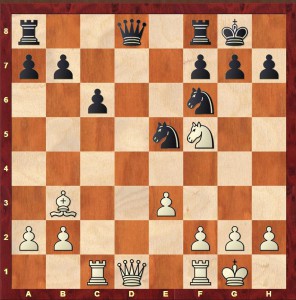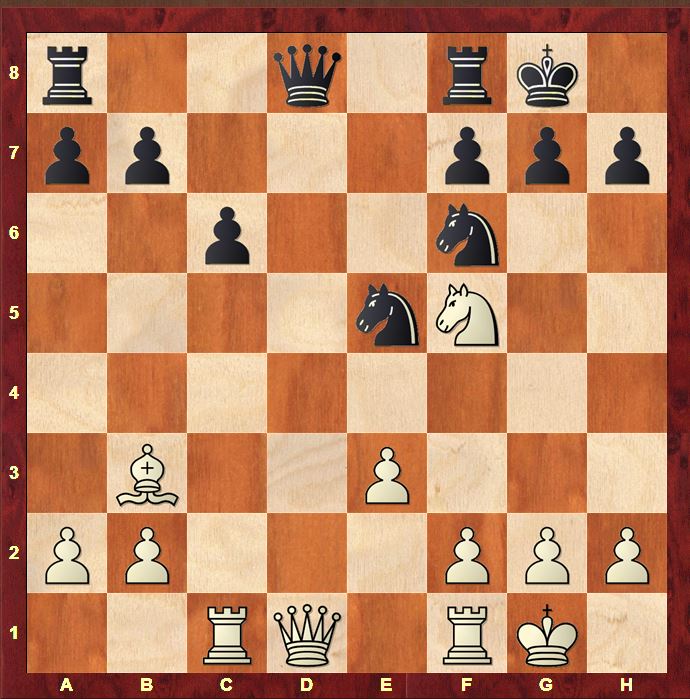Another famous Alekhine attack is his game against the 66-year old former World Champion Emanuel Lasker at Zurich 1934. I found some interesting lines while analysing, but what struck me the most was that I twice underestimated a variation involving the sacrifice of the queen for rook, bishop and pawn. After checking my analysis with Stockfish, I stood corrected!
The key moment arises in this position after Alekhine’s 17th move:

17…Qb6
A truly awful move! Black was presumably concerned about White plans starting with f4 and decided to forestall these by taking e3 under fire (18.f4 could now be met effectively with 18…Neg4). Unfortunately, this is a perfect example of poor piece coordination. After White’s next move, Black’s queen ends up cut off from the rest of her army. It is amazing how difficult – nigh on impossible – it is to get her back into the game!
18.Qd6 Ned7
None of Black’s options are tempting. The move played is not any worse than any other but I don’t think that it’s a good practical choice: it simply sets Black up to be a punching bag without introducing any risk into White’s position. Look how simply Alekhine won by bringing his pieces into play – he didn’t need to calculate any deep variations or sacrifice anything.
The key to Alekhine’s victory was the presence of the queen on the kingside: the manoeuvre Qg3–g5 was the last moment at which Alekhine needed to display his skill with the initiative. The rest was easy! For that reason, Black should be pulling out all the stops to prevent White’s queen from travelling to the kingside and he can only do that by holding the knight on e5… which is easier said than done! Black has 3 options
a) 18..Nfg4
It’s as risky as it looks!
19.h3 Rad8 Necessary but this leaves the a-pawn unprotected (19…Rfd8 20.Qe7) 20.Qc5 (20.Qe7 Ng6 (20…Rde8 21.Qg5) 21.Qg5 Nf6 22.Nh6+ gxh6 23.Qxf6 is similar to what Lasker rejected on move 18) 20…Qxc5 21.Rxc5 Nd3 22.Ra5 is another route to a clear advantage.
b) 18…Rfe8 Loses a pawn to a cunning tactic: 19.Ne7+ Kh8 20.Qxe5 Ng8
The key idea! The pin seems to win all Black’s material back but…
21.Nd5
21…Rxe5 22.Nxb6 axb6 23.Bxf7
I saw that Steve Giddins in his recent book “Alekhine Move-by-Move” for Everyman Chess also pointed this out! (the first person ever to do so!)
c)18…Rae8. This improves on 18…Rfe8 by keeping f7 defended. It does mean however that Black cannot easily shift the White queen from d6 as …Rd8 is no longer possible. White has 2 ways to play:
c1) 19.Rfd1 Kh8 20.h3 Preparing f4 and not fearing …Ne4 (20.Rd4 Qa5 looking for …Nf3+ 21.Rc5 Qe1#; 20.f4 Neg4)
I had a number of ideas now for Black:
i) 20…..Qa5 21.Rc5 The difference with 20.Rd4! 21…Qb4 22.Rxe5 Qxd6 23.Nxd6 Rxe5 24.Nxf7+ Rxf7 25.Bxf7;
ii) 20…Ne4 21.Qd4 This ending is very unpleasant – see the analysis of 20…Ng8 21.Qd2 Nf6 22.Qc3 Ne4 23.Qd4 which transposes.
iii) 20…Ng8 intending …g6 was my next idea after 20…Ne4
21.Qd2 to transfer the queen to c3 – not a bad alternative to a queen on the kingside! 21…Nf6
a. 22.Qc3 This is very unpleasant for Black 22…Ne4 (22…Qc7 23.f4 Ne4 24.Qd4) 23.Qd4 Qxd4 24.Rxd4 (24.exd4 Ng6 25.d5 Nf4 improves things for Black somewhat) 24…Nf6 25.f4 Ng6 26.Ra4 (26.g4 was my line, but Stockfish has a clear win) 26…a6 27.Rb4 Rb8 28.Nd6 is a horrible ending for Black.
Good enough, but there is also a tactical method. While analysing, my attention was caught by
b. 22.Nd6 Re7 23.Qc3 when I thought 23…Rd8 24.Qxe5 Rxe5 25.Nxf7+ Kg8 26.Rxd8+ Re8 27.Rxe8+ Nxe8 28.Ne5+ Kh8 (28…Kf8 29.Nd7+)
might be a miracIe hold for Black. But this turned out to be the first of my misjudged R & minor piece vs Q positions! Stockfish finds 29.Rd1 when the threat of Rd8 is unstoppable!
iv) 20…Ng6 looking for …Rd8 is the best.
After 21.Qd4 Black is worse but still surviving.
I was pretty pleased with my defensive effort here. Unfortunately, Stockfish’s evaluation rose to +1.7 when I put my analysis on! The reason was this:
c2) 19.Ne7+ Kh8 20.Qxe5 Ng8 (20…Qd8 21.Nxc6)
The key idea again of my line.
21.Nxc6 (21.Bxf7 Rxe7; 21.Ng6+ hxg6 22.Qg3 looked a little better for White but not too disastrous) 21…Rxe5 22.Nxe5
I had actually spotted this, but I hadn’t noticed at all that White is winning a second pawn by force due to the dual threat of Nxf7+ and Nd7!
22…Nf6 23.Nxf7+ Kg8 24.Rfd1 The resulting position is easy for a computer but maybe a little messy for a human to realise without some fear. I think it would be a reasonable practical option to offer this to a human during a game, while hoping for 19.Rfd1.
The game was very painful for Black
19.Rfd1 Rad8 20.Qg3 g6 21.Qg5 Kh8 22.Nd6 Kg7 23.e4
As Alekhine points out, this isn’t just to threaten e5 but also to open the 3rd rank for the White rook(s). John Nunn comments in his instructional manual based on Emanuel Lasker’s games (“John Nunn’s Chess Course”) “A rook on the 3rd rank plus a queen is very often a decisive attacking force even without additional assets”. Great attacking vision!
23…Ng8 24.Rd3 f6 25.Nf5+ Kh8 26.Qxg6
1–0
Another flowing Alekhine attack!



